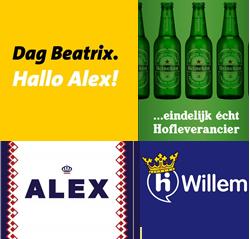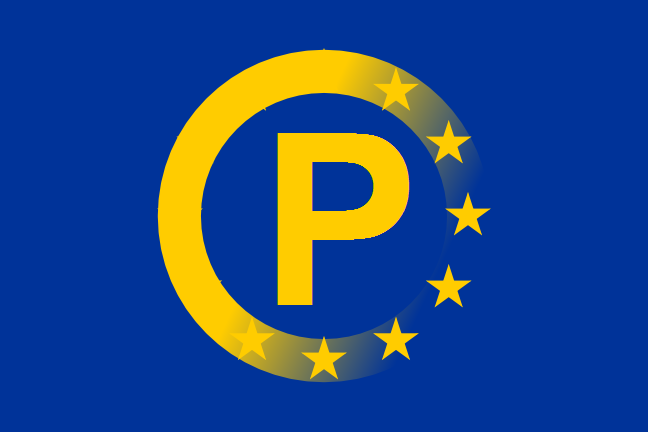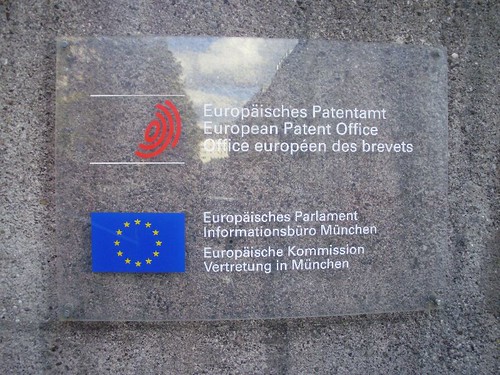De troonswisseling: Die Kroon past ons allemaal
Th.W. van Leeuwen, Die Kroon past ons allemaal, Abcor.nl.
 Een verkorte redactionele bijdrage van Theo-Willem van Leeuwen, Abcor merkenbureau.
Een verkorte redactionele bijdrage van Theo-Willem van Leeuwen, Abcor merkenbureau.
30 April is het zover. Koningin Beatrix treedt dan af en Nederland krijgt nu een Koning. Het Koninklijk Huis is in Nederland nog steeds mateloos populair dus de inhuldiging is voor het bedrijfsleven hét moment om hierop in te haken. Er zijn inmiddels al speciale vlaggen, T-shirts, mokken en misschien komt er zelfs een Koningssoep. Maar daar zal het zeker niet bij blijven. De vraag is natuurlijk wel; mag iedereen in zijn communicatie de namen en portretten van leden van het Koninklijk Huis zo maar vrijelijk gebruiken? Mag en kan het bedrijfsleven de namen van de leden van het Koninklijk huis gewoon als merk registreren? Wat mag nu eigenlijk wel of niet? (De complete nieuwsbrief Kroningsspecial is te vinden onder de button: nieuwsbrief-Abcor ABC-tje-nieuwsbrief 17).
Onderwerpen: Merkenrecht, Reclame, De Reclame Code Commissie (RCC), Kunst, Satire/parodie, Sociale Media en Do's and dont's
Merkenrecht
In de Benelux kunnen namen van leden van het Koninklijk Huis gewoon als merk geregistreerd worden. In de rechtspraak is al eerder bepaald, dat merkgebruik niet de indruk mag wekken dat het product of de dienst van rijkswege wordt bevorderd, gesteund of erkend. De autoriteiten zullen namen goedkeuren, zolang het teken niet een negatieve lading heeft. Zo werd bijvoorbeeld het merk TRIX IS NIX geweigerd door de autoriteiten omdat dit denigrerend was voor de koningin.
Reclame
De dag na de toespraak van Koningin Beatrix stonden de bladen vol met inhakende campagnes. Van “Dag Beatrix, Hallo Alex” (Jumbo) tot “… eindelijk écht Hofleverancier” (Heineken). De grote vraag is natuurlijk, mag dit allemaal zo maar? De RVD hanteert het standpunt dat je alleen het Koninklijk Huis mag feliciteren of geluk wensen. Een commerciële link is niet toegestaan, maar dat is in de praktijk een rekbaar begrip. Het is duidelijk dat je niet een lid iets mag laten aanprijzen, zonder zijn toestemming.
De Reclame Code Commissie (RCC)
Er is weinig rechtspraak over het gebruik van foto’s en namen van leden van het Koninklijk huis in reclame. Eigenlijk is dit wel logisch want als de staat een actie start, genereert dit direct veel publiciteit en kan dit gezien worden als een politiek statement. Wel zijn er de nodige uitspraken over het gebruik van politici in reclame. Vaak met een verbod als uitspraak omdat de afbeelding in strijd is met de goede zeden, onnodig denigrerend is of de suggestie wekt dat er wordt meegewerkt etc. Kwesties met het Koninklijk Huis spelen daarom vrijwel uitsluitend af bij de RCC. In het algemeen is de RCC wat strenger bij dit soort uitingen. De reden hiervan is, dat de RCC er van uitgaat dat het Koninklijk Huis zich minder goed kan verweren tegen een inbreuk op hun persoonlijke levenssfeer (gezien hun staatkundige positie). Zo vond de RCC de foto van een weglopende dame na de troonrede en de tekst “Oke, oke ik ga wel naar de VSB”, in strijd met het fatsoen. Maar niet iedere uiting lijkt tegenwoordig de RCC te halen. Er kwam geen protest van de RVD tegen de uiting van het Kruidvat waar de koningin de folder leest als troonrede (logisch want het mag duidelijk zijn dat de Koningin niet meegewerkt heeft aan deze uiting).
Kunst
Het Koninklijk Huis en de RVD voeren een veel minder streng beleid met betrekking tot kunstuitingen. Afbeeldingen van de koningin komen in menig kunstwerk voor. Zolang de producten maar niet commercieel geëxploiteerd worden, lijkt er veel te mogen.
Satire/parodie
Majesteitsschennis is in ons wetboek nog altijd strafbaar (art 111/112) Str. Een wet uit 1811. De ratio ervan is, dat de vorst een personificatie is van de staat, en een aanval op de vorst is een indirecte aanval op de staat. Het beledigen van de koning wordt gestraft met een geldboete of een gevangenisstraf van maximaal vijf jaar. De vrijheid van meningsuiting is tegenwoordig een zwaarwegend goed , waarbij het duidelijk is dat het om satire gaat. Zo zorgde het filmpje van Lucky TV over het vermeende staatsbezoek van onze koningin, Willem-Alexander en Maxima aan Papoea Nieuw Guinea wel voor veel ophef. Het hoofd van de koningin, Willem-Alexander en Maxima werden op naakte lichamen geplakt. Ook dit keer bleef een officiële waarschuwing uit.
Social Media
Het aanvragen van een Twitteraccount met andermans naam in Nederland is niet strafbaar. Twitter (maar ook andere social media, zoals Facebook) geeft namelijk de identiteit en persoonsgegevens van de aanvrager (om privacy redenen) niet vrij. Een bekende parodie is die van onze koningin, te vinden op Twitter via Koningin_NL (met bijna 150.000 volgers). Gezien de hype rond dit account is het een gemiste kans dat de RVD het Twitteraccount Koningsdag niet bij voorbaat heeft geclaimd.
Do’s and don’ts
Inhaken is nooit risicoloos, dus anticipeer:
- maak een insteker op actualiteit
- niet een hele campagne
- houd het netjes/ fatsoenlijk
- zorg voor een knipoog (wordt niet grof)
- voorkom directe aanprijzing
- suggereer niet dat de persoon werkelijk heeft meegewerkt aan de campagne
- vooral: zorg voor humor!


 Max Planck Institute
Max Planck Institute World Trademark Review
World Trademark Review De Brauw Legal Alert; Overhaul of EU Trademark System imminent: draft legislation leaked
De Brauw Legal Alert; Overhaul of EU Trademark System imminent: draft legislation leaked De IPO (Verenigd Koninkrijk) heeft een studie gedaan naar hoe vier auteursrechtindustrieën thuiskopiemaatregelen hebben geïmplementeerd en of de kosten van het product (voldoende) het thuiskopierecht weerspiegelt.
De IPO (Verenigd Koninkrijk) heeft een studie gedaan naar hoe vier auteursrechtindustrieën thuiskopiemaatregelen hebben geïmplementeerd en of de kosten van het product (voldoende) het thuiskopierecht weerspiegelt. Een bijdrage van Cees Mulder,
Een bijdrage van Cees Mulder,  Een bijdrage van Robbert Sjoerdsma,
Een bijdrage van Robbert Sjoerdsma,  VOI©E bericht
VOI©E bericht Een bijdrage van Richard Ebbink,
Een bijdrage van Richard Ebbink,  De status van de parodie is onder de loep genoemen in deze drie (Engelstalige) studies. Niet alleen benadrukken deze studies de parodie als een vorm van cultuuruiting, maar ook als een potentiële bron voor innovatie.
De status van de parodie is onder de loep genoemen in deze drie (Engelstalige) studies. Niet alleen benadrukken deze studies de parodie als een vorm van cultuuruiting, maar ook als een potentiële bron voor innovatie.






















































































